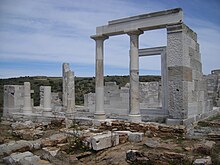Naxos marble



The Naxos marble or naxische marble (trade name: Marble Alexander ) is a coarsely crystalline, white marble , to be stone purposes on the Greek Cycladic island of Naxos is obtained. It is one of the most important marbles for ancient Greece. Marble is mined on the island until the modern age (2014).
Origin, mineralogy, properties
The marble owes its origin to metamorphic processes of a high degree in a contact zone with dome-like bulges of migmatites . They are interposed between these rocks and have a thickness of a few to 30 meters in the ancient fractures. The layers emphasize in northeast.
The white Naxos marble obtained consists of over 98 percent calcite . Accessory minerals are dolomite and silicates as well as traces of graphite and pyrite . The calcite crystals are random and are mostly transparent. This transparency creates a depth effect in the stone when viewed and is the cause of a blue-gray shimmer in the actually white marble, which can be perceived differently depending on the incidence of light. It has crystals up to 15 millimeters in size, making it one of the coarsest-grained marbles on earth. According to Raymond Perrier, it is resistant to frost and other weather conditions.
Other parts of the deposits are gray in color and clearly streaked, which suggests a higher proportion of foreign matter. This area also includes the unfinished statue of Kouros of Apollonas in a quarry near Apollonas at the north end of the island.
In some areas of the rock, gray, black and colored mineral grains of microscopic size are broken into the calcite crystals of the rock, so that the otherwise water-white calcite crystals are clouded. Minimal organic impurities are the cause of the bituminous minimal smell when the marble is handcrafted, which can no longer be detected afterwards. The individual crystals have a diameter of 5 millimeters and larger.
Quarries
Ancient marble quarries are located on Mount Agios Ioannis in the north of Naxos and near Apollonas and in the central area near Melanes . In the quarries there are also some unfinished antique pieces such as the Kouros by Apollonas or the two Kouroi by Flerio . The modern extraction sites are in the village of Kinidaros in the central part of the island.
history
The use of this marble has been proven since ancient Greece. It is one of the earliest used types of island marbles . The Naxian marble is one of the coarsest-grained marbles that were processed in antiquity.
Richard Lepsius already suspected the origin of those ancient marble roof tiles in Naxos that he examined in Olympia and on the Athens Acropolis , which the subsequent research confirmed. In Roman times, Naxian marble no longer played a role, Pliny does not even mention it.
Uses and designs
The Naxian marble is a sculptural and decorative stone. It is used for sculptures and interior design. In the Mediterranean area, it is also used outdoors. During the extraction process, care is taken to select white volumes early. This sorting effort has a direct impact on the price of raw materials and finished products sold. It is used on the island as a building material for window and door portals as well as for furniture inlays and arts and crafts objects; Overburden as gravel and for road construction.
There are numerous examples of simple and artistic uses on the island. These include a modern sphinx statue in front of the city administration in the city of Naxos , the remains of the Demeter temple near Sangri , the Poratara - the symbol of Naxos - or many walls in the villages.
literature
- C. Colotouros: Marble & Technology . Vol. 2. Athens (no year)
- K. Germann, Gottfried Gruben and others: Provenance Characteristics of Cycladic (Paros and Naxos) Marbles - A Multivariate Geological Approach. In: Classical Marble: Geochemistry, Technology, Trade. 1988, pp. 251-262.
- G. Richard Lepsius : Greek marble studies . Verlag der Königl. Academy of Sciences, Berlin 1890. ( full text )
- Friedrich Müller : International natural stone index compact . Sheet 82.4.
- Raymond Perrier: Les roches ornementales . Edition Pro Roc, Ternay 2004, ISBN 2-9508992-6-9 .
Individual evidence
- ↑ Perrier, p. 33.
- ^ Lepsius, p. 53.
- ^ Thomas Cramer: Multivariate origin analysis of marble on a petrographic and geochemical basis . Dissertation TU Berlin 2004, pp. 174–175. ( Full text )
- ↑ Lepsius, p. 55.
- ↑ Aenne Ohnesorg : Inselionische marble roofs. de Gruyter, Berlin 1993.
- ↑ INSK compact: 82.4 Naxos White . Ebner Verlag, Ulm

